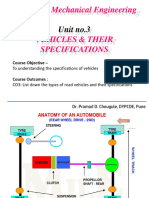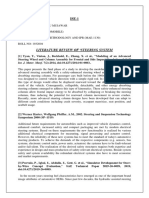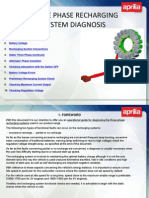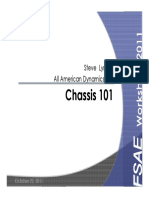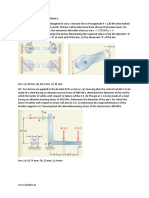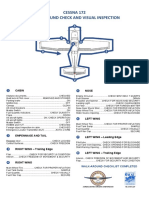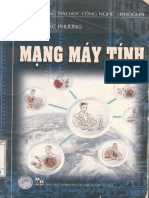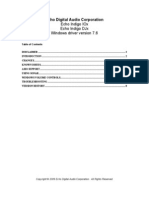Design of Double Wishbone Suspension System of BAJA Vehicle
Design of Double Wishbone Suspension System of BAJA Vehicle
Uploaded by
Sai Krishna SKCopyright:
Available Formats
Design of Double Wishbone Suspension System of BAJA Vehicle
Design of Double Wishbone Suspension System of BAJA Vehicle
Uploaded by
Sai Krishna SKOriginal Description:
Original Title
Copyright
Available Formats
Share this document
Did you find this document useful?
Is this content inappropriate?
Copyright:
Available Formats
Design of Double Wishbone Suspension System of BAJA Vehicle
Design of Double Wishbone Suspension System of BAJA Vehicle
Uploaded by
Sai Krishna SKCopyright:
Available Formats
e-ISSN (O): 2348-4470
Scientific Journal of Impact Factor (SJIF): 4.72
p-ISSN (P): 2348-6406
International Journal of Advance Engineering and Research
Development
Volume 4, Issue 12, December -2017
Design of Double Wishbone Suspension System of BAJA Vehicle
Nayan Deshmukh1, Vivek Singh Negi2, Amit Deshpande3
1
Department of Mechanical Engineering, Sinhgad Academy of Engineering, Kondhawa
2
Department of Mechanical Engineering, Sinhgad Academy of Engineering, Kondhawa
3
Department of Mechanical Engineering, Sinhgad Academy of Engineering, Kondhawa
Abstract — Independent motion of wheels, capable of navigating on uneven and bumpy road is important characteristic
of suspension system for BAJA vehicle. The system connects the wheels with chassis by means of an assembly, which
provides stiffness necessary to withstand shocks from roads. Suspension system dictates resistance to roll moment,
understeer or oversteer characteristics and many other factors. In this way, it is directly responsible for handling of
vehicle and safety. The suspension design must be quite stiff in order to bear sudden shocks due to potholes, steep drops,
etc. The suspension characteristics of vehicle aide in manueverablity and drive comfort. Therefore, correct design of
system is not only a matter of driver safety, but also a key factor in result of racing. The paper discusses various types of
suspension systems suitable for BAJA vehicle, the design methodology and results achieved by simulation. It is
paramount to select proper combination of spring and linkages to achieve optimum performance, with less weight. The
design of suspension system is iteration-based and requires correct compromise between comfort and performance, to
provide driver fatigue-less drive.
Keywords: Independent Suspension, Double Wishbones, Spring and Damper System, Roll Moment, ICR Diagram,
Simulation, Air Spring.
I. INTRODUCTION
The suspension system of BAJA vehicle has to withstand major shocks over uneven terrain. This calls for high stiffness
springing and rigid body. However, higher the stiffness, lesser will be the comfort. Hence, the driver will feel premature
fatigue and thereby the performance will be affected, on way or the other, in extreme use of springing. This is prevented
by finding optimum spot between comfort and performance. Spring stiffness is one of the major parameters in design
procedure. The choice of correct type and its characteristics can be of vital part in winning strategy.[1] Therefore, it is
important to specify the logic behind selecting such components. It is equally important to validate the selected data
using simulation software. This will ensure optimum performance characteristics and thereby enable designer to select
proper input variables.
The independent suspension is major part in modern vehicle design. Allowing wheels independent motion, unhampered
by relative displacement of linkages is base of comfort riding condition. The steering and suspension systems are crucial
for successful operation of any variety of cars. Due to the large responsibility that the these two major components share
coupled with the fact that BAJA cars are required to be capable of taking over toughest of the terrains possible, it is
obvious that consequences of failure or improper setup of the suspension and/or steering could be quite catastrophic.
The suspension system, which is widely used in off-road vehicles, like BAJA and Quad, and in many commercial
vehicles is independent suspension.[2] This gives freedom to wheels to oscillate about certain point, without disturbing
each other’s motion. This gives advantage over conventional solid axle, where both side wheels are directly coupled on
same member. The independent suspension is further segregated into various types, each with unique design and its
capabilities, wiz. McPherson strut, double wishbone, multilink suspension, trailing and semi-trailing arm, etc. Out of
these available design possibilities, double wishbone type suspension is selected which gives adequate space for wheel
assembly, better control over design characteristic and flexibility to designer in terms of performance variables.
II. Basic Concepts Related to Suspension of Vehicle
Before diving into the design, one must be familiar few concepts that play major role in design procedure, both directly
and indirectly. These terms are both controlling parameters as well as design variables in design.[2]
2.1 Caster angle:
Caster angle can be defined as the angle made by the kingpin in the side view with the vertical axis passing through the
wheel centre.Castor angle is very influential parameter in the dynamic behaviour of the vehicle. It is a stability oriented
@IJAERD-2017, All rights Reserved 852
International Journal of Advance Engineering and Research Development (IJAERD)
Volume 4, Issue 12, December-2017, e-ISSN: 2348 - 4470, print-ISSN: 2348-6406
property and is responsible for steering centric restoring force i.e. the amount of castor affects the feel of steering and the
amount of efforts required to turn the wheel. Figure below shows positive castor angle.
2.2 Caster Trail:
When the kingpin axis in the side view is extended further, it intersects ground at a particular point, the distance between
that point and centre of the contact patch is called castor offset or castor trail. Castor trail affects the resisting driver
effort. Some amount of castor trail is required for reducing driver effort.
2.3 Kingpin Inclination:
Kingpin inclination is defined as the angle at which kingpin axis is inclined to the vertical axis passing through the wheel
centre. Kingpin angle affects the performance of the car when the wheels are steered. More the kingpin angle more the
car will lift when steered. When the kingpin axis is extendedup to the ground, it intersects the ground at a particular
point. The distance of that point from the centre of wheel contact patch is called scrub radius. Scrub radius increases the
wear of the tyre but some amount of negative scrub radius is required so that the wheel purely rolls when steered.
2.4 Camber:
Camber is another important parameter in dynamic behaviour of the vehicle. Camber is defined as the angle between a
tilted wheel plane and the vertical. It is one of the important terms, which describes the suspension’s alignment. Camber
angle can have both negative as well as positive orientation. Camber is considered positive if the top of the wheel leans
outwards and negative if the top of the wheel leans inwards. If a vehicle’s wheels are properly cambered, a beneficial
thrust force is produced. This thrust force, aptly named as camber thrust, contributes a lateral force in the direction of
tyre’s tilt. In other words, it ensures stability by pulling the bottom of the tyre in the same direction in which the top is
leaning.
2.5 Toe:
Toe is final parameter used to describe a vehicle’s alignment. Toe is the symmetric angle that each wheel makes with the
longitudinal axis of the vehicle, as a function of static geometry, kinematic and compliant effects. Tyre wear is heavily
dependent on the toe distances. Dynamic factors induce change in toe, which lead to two conditions- toe in and toe out.
In rear wheel drive cars, increased front toe in provides greater straight-line stability at the cost of some sluggishness in
steering response.
2.6 Roll Centre;
The Roll Centre of a suspension system is that point in the transverse plane of the axles, about which the sprung mass of
that end of the vehicle will roll under the influence of that end of the vehicle will roll under the influence of centrifugal
force.
III. Objectives of Suspension System
The suspension system is designed keeping track of driver input and desired behaviour response of vehicle. Following
are the general objectives of double wishbone suspension system:
To provide all wheel independence.
Maintain ground and wheel contact for maximum amount of time throughout the ride.
Avoid excess rolling of the chassis.
To provide greater travel, this allows better absorption of the shocks during the changes in ground conditions.
To reduce un-sprung mass so as to have lesser inertia loads, thus the response time of the suspension to changes in
the track surface is minimized. This allows the tire to maintain constant contact with the surface as much as possible.
To provide better handling while cornering by providing camber gain.
Roll axis inclination is directly related to the steering characteristics of the vehicle. Hence, rear roll centre has to be
placed above the front roll centre to counter the effects of over-steering of the vehicle.
Validation of these objectives is done by simulation using MSC Adams car software package. This provides designer
ability to modify and accommodate different dimensions of rigid links and analyse their effect on final outcome. Thus, on
iteration basis, designer selects optimum values of design parameters, simulating the results in near-real-time.
@IJAERD-2017, All rights Reserved 853
International Journal of Advance Engineering and Research Development (IJAERD)
Volume 4, Issue 12, December-2017, e-ISSN: 2348 - 4470, print-ISSN: 2348-6406
IV. Components of Double Wishbone Suspension
Figure 1. Double Wishbone Suspension system
The suspension system is one constituent of a trio consisting steering system, wheel assembly and suspension system.
Therefore, few of its parts are common in either of those assemblies. Followings are major components in a double
wishbone suspension system:
4.1 Control Arms:
Control arms, in this case A-arms, are the rigid links that connect the wheel assembly with chassis, determine parameters
like roll centre position, static camber and camber gain. These are A- shaped links made from steel. These has to
withstand great bending force, partial impact loading from bumps and pots.[3] The dimensions of control arm are defied
by keeping in mind the outcome required. Their design procedure include combination of loading criteria and suspension
geometry as well. The material selection is done considering strength as the high preference factor; the lower control
arms are designed using 2 mm thickness; 1.25-inch AISI 1018 tube, while the upper control arms are designed using 1.2
mm; thickness 1.25-inch AISI 1018 tube.
4.2 Shock Absorber:
The shocks and impact loads on wheel are prevented from being transferred to the chassis by a shock absorber. Shock
Absorber is the most crucial component of the suspension system. The performance of a suspension system is directly
dependent on the performance of the shock absorbers.[4] Hence, proper selection of shock absorber is very much an
important criterion for better performance of the vehicle.
For selection of suitable shock absorbers, it is required to set desired natural frequency of the suspension system.
According to Allan Staniforth’s Competition Car Suspension,[5] the front frequency needs to be about 10 % lower than
the rear. This is to avoid pitching movement caused by the front wheels rising over a bump first, followed shortly
afterwards by the rears. Once started, it is at best unpleasant and at worst is capable of sending a jumping rally car into a
complete somersault. However, practical experience on the track shows that on good surfaces with high frequency
suspensions this "rule" is no longer necessarily valid and front frequencies may well be higher than the rear when a
search for better balance is going on. In case of BAJA vehicle, with the help of stiff shock absorbers, the pitching
movements are controlled greatly, but balance of the vehicle is critical. Hence, it is logical to go with more frequency at
the front than the rear. Studying various books related to the topic, it was decided to keep the natural frequency in the
range of 80-100 CPM (cycles per minute) for both front and rear.
Air spring is one of the most favoured type of shock absorber.Fox Float 3 shock absorbers were selected which provides
easy adjustment of stiffness and progressive damping.[6] The stiffness of the shock absorber can be easily changed by
changing the air pressure in the cylinder.
@IJAERD-2017, All rights Reserved 854
International Journal of Advance Engineering and Research Development (IJAERD)
Volume 4, Issue 12, December-2017, e-ISSN: 2348 - 4470, print-ISSN: 2348-6406
V. Design Considerations for Front Suspension Geometry
Following table shows values of general vehicle specifications required in design.
Table 1. General parameters required in design.
Parameters Values
Wheelbase 56”
Front 50”
Track-width:
Rear 50”
Ground Clearance 11.695”
King-pin Inclination 8⁰
King-pin Length 150 mm
King-pin Offset 90 mm
Castor Angle 11⁰
Scrub Radius 48.95 mm
Diameter 10”
Rim Dimensions:
Width 5”
Offset 3-2”
Outer Diameter 23”
Tyre Dimensions:
Inner Diameter 10”
Width 7”
The generation of geometry of font suspension includes specifying dimensions and relative positions of rigid linkages.
This is done by defining the desired goal and simultaneous simulation of each iteration with the help of Instantaneous
Centre of Rotation Method. Iterations for obtaining the suspension geometry are done using PTC Creo Parametric 2.0. To
avoid bump steer and to have optimum distance between the front roll-centre and CG is the desirable. A geometry that
yields the desired outcome was finalised. Length and angles of control arms and tie-rod was obtained from the geometry.
The ICR diagram generated for suspension geometry is shown below. The dimensions of linkages, their relative angular
positions and position of roll centre is also shown in the figure. This is the final iteration for specifying the dimensions.
Figure 2. ICR diagram of suspension system
After performing iterations, following parameters are finalised:
Table 2. Final geometry parameters
Parameters Values
Upper
Length 336.92 mm
Control
Angle 9.45°
Arm
Lower
Length 374.8 mm
Control
Angle 14.59°
Arm
Roll Centre Height 242.33 mm
@IJAERD-2017, All rights Reserved 855
International Journal of Advance Engineering and Research Development (IJAERD)
Volume 4, Issue 12, December-2017, e-ISSN: 2348 - 4470, print-ISSN: 2348-6406
VI. Simulation in MSC Adams Car Software Package
The geometry of the designed suspension system was imported into the simulation software. MSC Adams Car software
was used for simulating the suspension system. The results of simulation gave us a clear prospect of what our suspension
system was designed for. Figures showing simulation environment can be seen below.
Figure 3. Simulation of front suspension on MSC Adams
Suspension System was simulated for camber change with wheel travel, castor change with wheel travel and body roll
with respect to wheel travel. The graphs generated are attached below:
Figure 4. Camber Vs Wheel travel graph.
Figure 5. Graph of bump steer.
VII. FEA of Control Arms
FEA of A-arm was performed to get results on stresses and deformation of linkages. ANSYS software was used to
analyse the linkages.
Boundary conditions considered:
1. The A-arm chassis mounting points were considered frictionless support.
2. The point where shock absorber is mounted is considered a fixed support.
3. The A-Arm knuckle point is subjected to the bump force.
@IJAERD-2017, All rights Reserved 856
International Journal of Advance Engineering and Research Development (IJAERD)
Volume 4, Issue 12, December-2017, e-ISSN: 2348 - 4470, print-ISSN: 2348-6406
Followings are the results of FEA performed on model of A-Arm:
Figure 6. Boundary condition for A-arm
Figure 7. Von mises stress in A-arm
The maximum stress occurring in A-arm is 368.21N/mm2
Figure 8. Deformation of A-arm
The maximum deformation in A-arm is 1.01 mm.
VIII. Calculations for Roll Rate
8.1 Abbreviations and input values:
G = 9.81m/s²
Mass on front wheels = 96 kg (mf)
Mass on rear wheels= 144 kg (mr)
C.G front, hf = 355.6 mm
C.G rear, hr = 405.6 mm
RC height, RCF = 242.33mm
RC height, RCR = 250mm
Front track, TF=1270mm
Rear track, TR=1270mm
Front spring roll rate = Kᵩfrlbs.ft/°
Rear spring roll rate = Kᵩsrlbs.ft/°
Front ride rate = KRF lbs./in.
Rear ride rate = KRR lbs./in
Front ride rate frequency = w f = KRR lbs./in
@IJAERD-2017, All rights Reserved 857
International Journal of Advance Engineering and Research Development (IJAERD)
Volume 4, Issue 12, December-2017, e-ISSN: 2348 - 4470, print-ISSN: 2348-6406
Roll moment front =M1gf N/m
Roll moment rear= M1gr N/m
8.2Front Ride Rate:
From Race Car Vehicle Dynamics written by William F. Milliken and Douglas L. Milliken,[1]
Front spring roll rate:
K RF∗ TF²
KᵩSF =
1375
1270
29.4 × ( )²
25.4
=
1375
KᵩSF = 53.45 Nm/°
53.45 × 4.4482
KᵩSF = 1000
( )
12×25.4
KᵩSF=72.5 Nm/°
8.3 Roll moment for the front at 1g acceleration:
M1gf = (hf ˗ RCf) mfg
M1gf = (0.556-0.24233)×96×9.81
M1gf = 106.67 Nm
𝑅𝑜𝑙𝑙 𝑚𝑜𝑚𝑒𝑛𝑡
Roll rate at front =
KᵩSF
106.67
=
72.5
Roll rate at front= 1.47°/g
8.4 Calculations for Coil Rate of shock absorber:
Desired Natural Frequency = 100 CPM or 1.667 Hz
Sprung Mass at the front = 80.75 kg
Wheel Rate (lbs./in.):
Wheel Frequency (CPM ) 2
WR = ∗ Sprung Weight (lbs)
187.8
100 2 80.75
= ∗ * 9.81 * 0.2248
187.8 2
= 25.24 lbs./in.
@IJAERD-2017, All rights Reserved 858
International Journal of Advance Engineering and Research Development (IJAERD)
Volume 4, Issue 12, December-2017, e-ISSN: 2348 - 4470, print-ISSN: 2348-6406
Assume,
Motion Ratio (Suspension leverage) = 1:1
Coil rate = Wheel rate * (Suspension leverage) ²
= 25.24 * (1) ²
Coil Rate = 25.24 lbs./in.
8.5Final Iteration:
For Motion Ratio = 0.7
Coil Rate = Wheel Rate * (Suspension leverage) ²
1
Coil Rate = 25.24 * ²
0.7
Coil Rate = 49.61 lbs./in.
IX. Results
Following table consists of values of final design parameters:
Table 3. Result of simulation and calculations
Parameter Value
Front Spring roll rate 72.5 Nm/°
Roll rate at front 1.47°/g
Wheel Rate 25.24 lbs./in.
Motion ratio 0.7
Coil Rate 49.61 lbs./in.
Wheel Frequency 99 CPM or 1.65 Hz
X. Conclusion
After initial testing of the sub-systems designed, it was observed that the systems fulfilled their individual performance
expectations. The suspension system has near about optimum steer characteristics. Thus, aiding the driver handle the
vehicle better. The design goals are validated through simulation, as the system yields required output. The calculations
describe values of roll rate at front, wheel rate and coil rate along with wheel frequency. In this way, the design of
suspension system is successfully completed and serves as ground for further research on said topic
XI. References
1. Milliken and Milliken, “Race car dynamics”, 1994.
2. Riempell, “The Automotive Chassis”, Heinemann-Butterworth, McGraw Hill Publication, 1992
3. John C. Dixon, “Suspension Geometry and Computation”, Wiley Publications.
4. Carrol Smith, “Tune to Win”, Aero Publications, Inc.
5. Allan Staniforth, “Competition Car Suspension – Design, Construction, Tuning”, Third Edition, Haynes
Publications.
6. John C. Dixon, “The Shock Absorber Handbook”, Wiley Publications, 2nd Edition.
@IJAERD-2017, All rights Reserved 859
You might also like
- Ford Service Manual 1920 Tractor Diesel Compact 2120 TractorDocument18 pagesFord Service Manual 1920 Tractor Diesel Compact 2120 Tractornmclaugh33% (3)
- Active Suspension System Power Point PresentationDocument30 pagesActive Suspension System Power Point PresentationJAYNo ratings yet
- Design Analysis of Fsae Suspension System PDFDocument9 pagesDesign Analysis of Fsae Suspension System PDFRushik KudaleNo ratings yet
- Bus, Truck Manufacturing ProcessDocument11 pagesBus, Truck Manufacturing ProcessRavesh KaulNo ratings yet
- Bike Towing Mechanism: Submitted By: Mandar Patki S-22 (152021) Pratik Vaidya S-35 (152129) Saket Wakde U-37 (152056)Document15 pagesBike Towing Mechanism: Submitted By: Mandar Patki S-22 (152021) Pratik Vaidya S-35 (152129) Saket Wakde U-37 (152056)pratikNo ratings yet
- Design and Analysis of Disc Brake RotorsDocument55 pagesDesign and Analysis of Disc Brake RotorsRajashekar Lokam100% (2)
- Model and Analysis On Car Seat Mounting BracketDocument6 pagesModel and Analysis On Car Seat Mounting BracketseventhsensegroupNo ratings yet
- Design and Fabrication of Foldable Electric Motor Powered Three Wheel Vehicle Ijariie5592Document35 pagesDesign and Fabrication of Foldable Electric Motor Powered Three Wheel Vehicle Ijariie5592UNITED CADD100% (2)
- Project Report On Regenerative Shock AbsorberDocument24 pagesProject Report On Regenerative Shock AbsorberTheVagabond Harshal33% (3)
- MAS-10 Steering System and Wheel Alignment PDFDocument25 pagesMAS-10 Steering System and Wheel Alignment PDFJ Naveen KumarNo ratings yet
- Electro-Magnetic Breaking-Black BookDocument48 pagesElectro-Magnetic Breaking-Black BookAnjali BiramaneNo ratings yet
- Maruti Suzuki Training ReportDocument26 pagesMaruti Suzuki Training ReportRehan Sharma100% (2)
- Automotive SafetyDocument50 pagesAutomotive SafetyPoorni Jayaraman0% (1)
- Design Optimization of Two Wheeler (Bike) ChassisDocument5 pagesDesign Optimization of Two Wheeler (Bike) ChassisPrakash KatdareNo ratings yet
- Brake CalculationsDocument36 pagesBrake CalculationsAnuragKarnaNo ratings yet
- Worksheet 4 PDFDocument2 pagesWorksheet 4 PDFtewodrosNo ratings yet
- Chassis Desgin Univ 2 MarksDocument7 pagesChassis Desgin Univ 2 Markspavanrane67% (3)
- Chapter 2 (1) - 1Document16 pagesChapter 2 (1) - 1Shuguta LatiNo ratings yet
- 2 Stroke EngineDocument4 pages2 Stroke EngineSaint BoyetNo ratings yet
- Unit - I: Car BodyDocument61 pagesUnit - I: Car BodyVi JäìNo ratings yet
- Types of Vehicle LayoutDocument7 pagesTypes of Vehicle LayoutAnk VaaiNo ratings yet
- Gasoline Direct InjectionDocument37 pagesGasoline Direct InjectionSAMNo ratings yet
- Fabrication of Self Balancing Two Wheeler Using Gysroscope.02Document20 pagesFabrication of Self Balancing Two Wheeler Using Gysroscope.02milan mottaNo ratings yet
- DamperDocument52 pagesDampergnaniofs3960No ratings yet
- "Designing and Fabrication of Multi Mode Sterring System": Project ReportDocument35 pages"Designing and Fabrication of Multi Mode Sterring System": Project ReportTejraj KakadeNo ratings yet
- At2402 NotesDocument7 pagesAt2402 NotesAnonymous ETBwIduGiNo ratings yet
- 82 Automotive Hydraulic Brake System Service RevisedDocument82 pages82 Automotive Hydraulic Brake System Service Reviseddmc constructionNo ratings yet
- Assignment ClutchDocument624 pagesAssignment ClutchSubhash KNo ratings yet
- Unit 3 Vehicle and Their SpecificationsDocument48 pagesUnit 3 Vehicle and Their Specificationssiddh2805No ratings yet
- Independent Suspension SystemDocument28 pagesIndependent Suspension Systemvishnu13141No ratings yet
- (##) Automatic Pneumatic Braking and Bumper SystemDocument95 pages(##) Automatic Pneumatic Braking and Bumper SystemArjun Raghavan100% (5)
- Cylinder Reboring Machine and Surface GrinderDocument1 pageCylinder Reboring Machine and Surface Grinderdaya shanker shukla100% (1)
- Gear Box SumDocument13 pagesGear Box SumVasanthe Roy J TeachingNo ratings yet
- Nitro Shock SynopsisDocument4 pagesNitro Shock SynopsisChandanSuriyaNo ratings yet
- Design, Modeling and Failure Analysis of Car Front Suspension Lower ArmDocument15 pagesDesign, Modeling and Failure Analysis of Car Front Suspension Lower ArmMikael Bezerra Cotias Dos SantosNo ratings yet
- Tilting Three Wheeler DesignDocument16 pagesTilting Three Wheeler DesignAkash ChaudhariNo ratings yet
- Automatic Screw Jack Project ReportDocument12 pagesAutomatic Screw Jack Project ReportKaran Bansal67% (3)
- Auto ErgonomicDocument4 pagesAuto ErgonomicAnshul BediNo ratings yet
- Motorcycle Suspension ReportDocument3 pagesMotorcycle Suspension Reportrls8880% (1)
- Nptel: Vehicle Dynamics - Video CourseDocument2 pagesNptel: Vehicle Dynamics - Video CourseManoj BENo ratings yet
- Literature Review of Steering SystemDocument2 pagesLiterature Review of Steering SystemGirish Mujawar100% (1)
- 90 Degree Turning Motorized Steering MechanismDocument62 pages90 Degree Turning Motorized Steering MechanismMani Kandan100% (1)
- Chapter-2 Understanding Auto Body ConstructionDocument7 pagesChapter-2 Understanding Auto Body ConstructionAmanuelNo ratings yet
- Suspensions: Coil&Leaf Springs and Air SuspensionDocument28 pagesSuspensions: Coil&Leaf Springs and Air SuspensionHithesh SainadhNo ratings yet
- Automatic Transmission5 ReportDocument17 pagesAutomatic Transmission5 ReportManhar MidhaNo ratings yet
- Aprilia 3-Phase Recharging System DiagnosisDocument15 pagesAprilia 3-Phase Recharging System DiagnosisManuallesNo ratings yet
- Adaptive Lighting System For AutomobilesDocument30 pagesAdaptive Lighting System For AutomobilesDeepthi Dsouza100% (1)
- Clever Three Wheeler Vehicle - 1482838722189 - 1483002318900Document20 pagesClever Three Wheeler Vehicle - 1482838722189 - 1483002318900Saleem SalluNo ratings yet
- Fabrication of Dual Brake in Single Liver SystemDocument7 pagesFabrication of Dual Brake in Single Liver SystemMalarNo ratings yet
- Chassis 23 PDFDocument89 pagesChassis 23 PDFpartizan21No ratings yet
- High Speed Off-Road Vehicles: Suspensions, Tracks, Wheels and DynamicsFrom EverandHigh Speed Off-Road Vehicles: Suspensions, Tracks, Wheels and DynamicsNo ratings yet
- Chassis Dynamometer Testing: Addressing the Challenges of New Global LegislationFrom EverandChassis Dynamometer Testing: Addressing the Challenges of New Global LegislationNo ratings yet
- Plug-In Hybrid Electric Vehicles The Ultimate Step-By-Step GuideFrom EverandPlug-In Hybrid Electric Vehicles The Ultimate Step-By-Step GuideNo ratings yet
- Take Away KitDocument2 pagesTake Away KitSai Krishna SKNo ratings yet
- ExternalDocument17 pagesExternalSai Krishna SKNo ratings yet
- CFD Analysis On Hdpe Double Pipe Heat ExchangerDocument8 pagesCFD Analysis On Hdpe Double Pipe Heat ExchangerSai Krishna SKNo ratings yet
- Take Away Kit PDFDocument2 pagesTake Away Kit PDFSai Krishna SKNo ratings yet
- Slide 1prinicipal Component AnalysisDocument2 pagesSlide 1prinicipal Component AnalysisSai Krishna SKNo ratings yet
- Sae Baja Chassis: Step 1: Step 1: LEARN THE RULES!!!!!Document17 pagesSae Baja Chassis: Step 1: Step 1: LEARN THE RULES!!!!!Sai Krishna SKNo ratings yet
- SAEDocument12 pagesSAESai Krishna SKNo ratings yet
- Seminar Presentation: Types of Geo-Thermal Power PlantsDocument7 pagesSeminar Presentation: Types of Geo-Thermal Power PlantsSai Krishna SKNo ratings yet
- Oracle in Erp: Presenting By: Sai Krishna Jaligama 16K81A03D6Document9 pagesOracle in Erp: Presenting By: Sai Krishna Jaligama 16K81A03D6Sai Krishna SKNo ratings yet
- CFD Analysis of Automotive Ventilated Disc Brake Rotor: Amol V. More, Prof - Sivakumar RDocument5 pagesCFD Analysis of Automotive Ventilated Disc Brake Rotor: Amol V. More, Prof - Sivakumar RSai Krishna SKNo ratings yet
- Cad CamDocument50 pagesCad CamSai Krishna SKNo ratings yet
- Charan SeminorDocument19 pagesCharan SeminorSai Krishna SKNo ratings yet
- Baja SAE - 2018 Cost Report SubmissionDocument23 pagesBaja SAE - 2018 Cost Report SubmissionSai Krishna SKNo ratings yet
- Presentation Layer PPT 1 PDFDocument16 pagesPresentation Layer PPT 1 PDFSai Krishna SKNo ratings yet
- Oop in Python Best ResourcesDocument1 pageOop in Python Best ResourcesSamuel ForknerNo ratings yet
- SOM Sheet 3: Complex Stresses - 2 Minute QuestionsDocument2 pagesSOM Sheet 3: Complex Stresses - 2 Minute QuestionsSai Krishna SKNo ratings yet
- SFD, BMD and Deflection of Beams Question SheetDocument4 pagesSFD, BMD and Deflection of Beams Question SheetSai Krishna SKNo ratings yet
- Simple Stresses and Strains PDFDocument2 pagesSimple Stresses and Strains PDFSai Krishna SK100% (1)
- Simple Stresses and Strains PDFDocument2 pagesSimple Stresses and Strains PDFSai Krishna SK100% (1)
- Ansys PDFDocument9 pagesAnsys PDFSai Krishna SKNo ratings yet
- A Pipelined Datapath: Resisters Are Used To Save Data Between StagesDocument14 pagesA Pipelined Datapath: Resisters Are Used To Save Data Between StagesJohnDaGRTNo ratings yet
- XP9200Document1 pageXP9200Chu ChuNo ratings yet
- Computing Experiment For Unloading Dumper Truck at A Sloping PadDocument8 pagesComputing Experiment For Unloading Dumper Truck at A Sloping PadLong ThànhNo ratings yet
- Download Hebrew and Zionism A Discourse Analytic Cultural Study Ron Kuzar ebook All Chapters PDFDocument77 pagesDownload Hebrew and Zionism A Discourse Analytic Cultural Study Ron Kuzar ebook All Chapters PDFciviljahicip100% (6)
- Parametric & Non-Parametric Test... (Stats) Part2Document4 pagesParametric & Non-Parametric Test... (Stats) Part2rajsj100% (1)
- Q1-Week 8Document5 pagesQ1-Week 8Oclarit Joseph CarlNo ratings yet
- LatestcrashDocument2 pagesLatestcrashLeese20030327No ratings yet
- American Airlines Case StudyDocument9 pagesAmerican Airlines Case Studyjimmypixel6048No ratings yet
- Attitudes Not Set in Stone Existential Crises Changing R 2023 Tourism ManagDocument7 pagesAttitudes Not Set in Stone Existential Crises Changing R 2023 Tourism ManagFirman JuliansyahNo ratings yet
- 7-Deconstructing Life (In Art and Science)Document5 pages7-Deconstructing Life (In Art and Science)mis_administratorNo ratings yet
- CW 01 With AnswersDocument6 pagesCW 01 With AnswersMohammad Aamir Perwaiz100% (3)
- Lemh 207Document33 pagesLemh 207arafin8rcsNo ratings yet
- By Roger S. Pressman and Bruce R. Maxim: Software Engineering: A Practitioner's Approach, 8/eDocument16 pagesBy Roger S. Pressman and Bruce R. Maxim: Software Engineering: A Practitioner's Approach, 8/eJerome 高自立 KoNo ratings yet
- Janome 6260QC Sewing Machine Service ManualDocument35 pagesJanome 6260QC Sewing Machine Service ManualiliiexpugnansNo ratings yet
- Course Title: Theory of Structures-Ii Course Code: 4014 Course Category: B Periods/Week: 6 Periods/Semester: 78 Credits: 5Document4 pagesCourse Title: Theory of Structures-Ii Course Code: 4014 Course Category: B Periods/Week: 6 Periods/Semester: 78 Credits: 5VaisakVenugopalNo ratings yet
- Shivalik Institute of Management Education & Research Shivalik Institute of Management Education & ResearchDocument25 pagesShivalik Institute of Management Education & Research Shivalik Institute of Management Education & ResearchforrajeshNo ratings yet
- CHAPTER 5 Measures of Central Tendency and VariabilityDocument17 pagesCHAPTER 5 Measures of Central Tendency and VariabilityErdanlove DielNo ratings yet
- Jana Lesson Plan LandformsDocument2 pagesJana Lesson Plan LandformsJana Shanne ValdezNo ratings yet
- Walk Around Check and Visual Inspection C172Document1 pageWalk Around Check and Visual Inspection C172alphaNo ratings yet
- AL MidSem ReportDocument55 pagesAL MidSem ReportVikas KamathNo ratings yet
- Tailieuxanh Mang May Tinh NXB Dai Hoc Quoc Gia Phan 1 6058Document215 pagesTailieuxanh Mang May Tinh NXB Dai Hoc Quoc Gia Phan 1 6058thanhnhanNo ratings yet
- Piston Seal Kit 0995-M12Document2 pagesPiston Seal Kit 0995-M12Daniel MarNo ratings yet
- VIDAS EASY SLMDocument1 pageVIDAS EASY SLMDiegoGarciaNo ratings yet
- Reading Comprehension Part 1Document6 pagesReading Comprehension Part 1darius mercadoNo ratings yet
- Gon Carly May 8 ResumeDocument5 pagesGon Carly May 8 Resumeapi-345711224No ratings yet
- Course Outline 618386Document5 pagesCourse Outline 618386abrehamararsaNo ratings yet
- Wind Load: K Z S Z 0Document1 pageWind Load: K Z S Z 0MechanicalNo ratings yet
- Boiler RLADocument4 pagesBoiler RLAGaneshNo ratings yet
- Echo Digital Audio Corporation: Echo Indigo Iox Echo Indigo DJX Windows Driver Version 7.6Document8 pagesEcho Digital Audio Corporation: Echo Indigo Iox Echo Indigo DJX Windows Driver Version 7.6Lillynsunny ThomasNo ratings yet






























